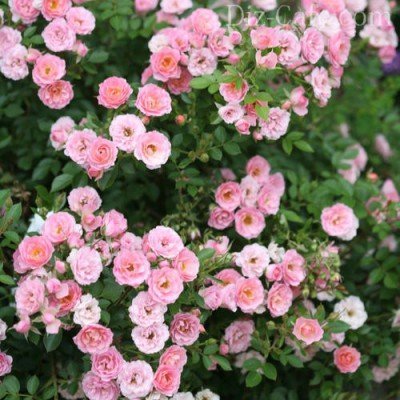Ground-cover roses in the garden design
Many blossoming since the spring before frost and light in growing, ground cover roses are resistant to various diseases and winter colds. In the design of the garden landscape, they are flawless for the decoration of gentle slopes and the creation of low plant borders along the paths. Planted in flowerpots or for raised flower beds, creeping roses look mostly beautiful because of the dewy hanging branches, dotted with caps of inflorescences, and then - the brightest autumn fruits. Flowerbeds with ground-cover roses rising above the level of a plot are not enough of that which aesthetically look almost the whole year, allow to solve quite easily the problem with lean grounds and drainage of the rosary - the fenced place can be filled with a grassy soil consistency and remove excess water. Many full-blooming full-season, ground-cover roses of pastel colors make delicate frames for lawns and green lawns
wp-content/uploads/2014/05/poch_roza_klum1-e1401064379426.jpg"rel="lightbox[7070]"title="Клумба случайной формы с почвопокровными розами">
Увлекательным решением ради декора сада может выступить клумба с почвопокровными розами, повторяющая очертания дорожкиThe basic meaning for the sake of successful feeding of all kinds of roses, including soil cover, in the open ground is the acidity of the earth, because the regal flower is rather whimsical - neither the critically acidic soil effect with pH less than 7 nor alkaline pH greater than 7. Balanced version - a land with a weakly acid reaction within 5.5 before 6.5 pH.
In order to find the acidity of the soil, it is permissible to extract litmus paper, which, if assisted with the aqua substance of the earth, will change the paint for the blue, if alkali prevails in the ground or for the reddish-to be excess of acid. More precise analyzes of soils are made by special universities of agricultural profile. Lands with high acidity are neutralized by crushed limestone, gypsum, bone or dolomite flour, ash. To be an alkaline earth reaction, it is acidified with superphosphate, grayish, peat, coniferous or leaf humus. Due to the 3 tiers formed by the creeping and stamping roses in the composition with lavender, the short, according to the area, the rose garden looks like a catchy accent in the garden landscape

Увлекательным решением ради декора сада может выступить клумба с почвопокровными розами, повторяющая очертания дорожкиThe basic meaning for the sake of successful feeding of all kinds of roses, including soil cover, in the open ground is the acidity of the earth, because the regal flower is rather whimsical - neither the critically acidic soil effect with pH less than 7 nor alkaline pH greater than 7. Balanced version - a land with a weakly acid reaction within 5.5 before 6.5 pH.
In order to find the acidity of the soil, it is permissible to extract litmus paper, which, if assisted with the aqua substance of the earth, will change the paint for the blue, if alkali prevails in the ground or for the reddish-to be excess of acid. More precise analyzes of soils are made by special universities of agricultural profile. Lands with high acidity are neutralized by crushed limestone, gypsum, bone or dolomite flour, ash. To be an alkaline earth reaction, it is acidified with superphosphate, grayish, peat, coniferous or leaf humus. Due to the 3 tiers formed by the creeping and stamping roses in the composition with lavender, the short, according to the area, the rose garden looks like a catchy accent in the garden landscape
wp-content/uploads/2014/05/poch_roza_9-e1401066103430.jpg"rel="lightbox[7070]"title="Краска махровой почвопокровной розы">
Благодаря множественным маленьким соцветиям, розарий из почвопокровных роз — это завсегда видный и блестящий место садаBefore the breakdown, the rosary also needs to analyze which crops grew earlier for the selected site. It is unacceptable to plant roses where the rosary existed for 7-10 years, or grew rosaceous - hawthorn, irga, pear, apricot, cherry, others. Though, to be desired, depleted soil is allowed to be chosen for a depth of 50 cm and replaced by a greasy consistency consisting of clay, compost, mineral fertilizers, humus or perfectly reparted manure. Ground-capped roses can begin with the harmonic addition of a multi-level hectic hedge by forming a finger or a lower tier

Благодаря множественным маленьким соцветиям, розарий из почвопокровных роз — это завсегда видный и блестящий место садаBefore the breakdown, the rosary also needs to analyze which crops grew earlier for the selected site. It is unacceptable to plant roses where the rosary existed for 7-10 years, or grew rosaceous - hawthorn, irga, pear, apricot, cherry, others. Though, to be desired, depleted soil is allowed to be chosen for a depth of 50 cm and replaced by a greasy consistency consisting of clay, compost, mineral fertilizers, humus or perfectly reparted manure. Ground-capped roses can begin with the harmonic addition of a multi-level hectic hedge by forming a finger or a lower tier
wp-content/uploads/2014/05/poch_roza_14-e1401066042576.jpg"rel="lightbox[7070]"title="Почвопокровная роза в декоре забора и перголы">
Благодаря обильному цвету, почвопокровные розы образуют яркий ковер, даровитый воскресить городьба либо перголуBe the location of ground cover roses in compositions with other garden plants - in mixborders, flowerbeds, the desire to anticipate rational distances between groups of planting in order to ensure that the rest, fertilizing, watering similar to flowers for the sake of colors is not damaged without damaging their"neighbors". The gap between the rose bushes in the flower garden fluctuates 30 cm in front of the meter and depends on the corresponding characteristics of the variety, the shape and size of the bush, the growth intensity of the shoots.
Stop #2 - preparing for landing
Wells for the sake of planting ground-rooted roses are best prepared in advance - at least from about a week before moving the seedlings to the ground. For the autumn planting it is normal to collect pits in the spring, for the sake of spring - in the autumn, marking out in advance a part taking into account the shape and growth of bushes:
Seedling in the container. Despite the fact that the suppliers of planting material recommend planting a rose in the grid, often its root order is not prepared in a proper way to this procedure - the tips of the root shoots are bent or broken. Therefore, the rhizome of the rose must be carefully released through packaging, shortened before 30-35 cm, to remove broken or warped shoots. In most cases, the integrity of the coma does not violate, but in order to provoke the root of the root system, make in it fairly cuts for a depth of 2 cm.
Seedling with an open rhizome. If a seedling of a landscape rose was purchased with an open cropped root system, it is recommended that its slices be renewed before planting. To be given to the root system, drying of its shoots is often observed, therefore, we recommend that you hold the roots of the flower in the water during the day before moving to the open land.
High-quality and vigorous roses seedlings must own 3 perfectly developed shoots and a rather branched root system with a significant number of small shoots. Direct the attention so that the diameter of the stock and the graft are similar - within 6-8 cm. Before planting in the garden, the foliage and kidneys located below the inoculation are removed from the shoots of the flower, the broken and non-branched branches are trimmed, the rhizome is shortened almost before the length of 20-35 cm, and the above-ground share is in front of 25-35 cm. Before planting ground-cover roses for a garden plot, it is recommended to decontaminate seedlings with 5% copper sulfate, and dip their roots into a creamy mess of clay mash and mullein in a proportion of 2 to 1. White foam woven from ground cover plants will give the decorative flower border a breathtaking spectrum

Благодаря обильному цвету, почвопокровные розы образуют яркий ковер, даровитый воскресить городьба либо перголуBe the location of ground cover roses in compositions with other garden plants - in mixborders, flowerbeds, the desire to anticipate rational distances between groups of planting in order to ensure that the rest, fertilizing, watering similar to flowers for the sake of colors is not damaged without damaging their"neighbors". The gap between the rose bushes in the flower garden fluctuates 30 cm in front of the meter and depends on the corresponding characteristics of the variety, the shape and size of the bush, the growth intensity of the shoots.
Stop #2 - preparing for landing
Wells for the sake of planting ground-rooted roses are best prepared in advance - at least from about a week before moving the seedlings to the ground. For the autumn planting it is normal to collect pits in the spring, for the sake of spring - in the autumn, marking out in advance a part taking into account the shape and growth of bushes:
Seedling in the container. Despite the fact that the suppliers of planting material recommend planting a rose in the grid, often its root order is not prepared in a proper way to this procedure - the tips of the root shoots are bent or broken. Therefore, the rhizome of the rose must be carefully released through packaging, shortened before 30-35 cm, to remove broken or warped shoots. In most cases, the integrity of the coma does not violate, but in order to provoke the root of the root system, make in it fairly cuts for a depth of 2 cm.
Seedling with an open rhizome. If a seedling of a landscape rose was purchased with an open cropped root system, it is recommended that its slices be renewed before planting. To be given to the root system, drying of its shoots is often observed, therefore, we recommend that you hold the roots of the flower in the water during the day before moving to the open land.
High-quality and vigorous roses seedlings must own 3 perfectly developed shoots and a rather branched root system with a significant number of small shoots. Direct the attention so that the diameter of the stock and the graft are similar - within 6-8 cm. Before planting in the garden, the foliage and kidneys located below the inoculation are removed from the shoots of the flower, the broken and non-branched branches are trimmed, the rhizome is shortened almost before the length of 20-35 cm, and the above-ground share is in front of 25-35 cm. Before planting ground-cover roses for a garden plot, it is recommended to decontaminate seedlings with 5% copper sulfate, and dip their roots into a creamy mess of clay mash and mullein in a proportion of 2 to 1. White foam woven from ground cover plants will give the decorative flower border a breathtaking spectrum
wp-content/uploads/2014/05/poch_roza_shr-e1401062561901.jpg"rel="lightbox[7070]"title="Почвопокровные розы в виде штамба">
Необыкновенная репутация почвопокровных роз привела к созданию гибридов, объединяющих внутри себя свойства ковровой и штамбовой розы

Необыкновенная репутация почвопокровных роз привела к созданию гибридов, объединяющих внутри себя свойства ковровой и штамбовой розы
wp-content/uploads/2014/05/poch_roza_6-e1401062481119.jpg"rel="lightbox[7070]"title="Пышноватые соцветия махровой почвопокровки">
Необыкновенная декоративность цвета почвопокровных роз в композиции с их неприхотливостью, снискали этим сортам массовую репутация у садоводов

Необыкновенная декоративность цвета почвопокровных роз в композиции с их неприхотливостью, снискали этим сортам массовую репутация у садоводов
wp-content/uploads/2014/05/poch_roza_51.jpg"rel="lightbox[7070]"title="Почвопокровная роза у лавки">
Почвопокровная роза создаст действительно уникальный место сада, ясный из за счет огромного количества соцветий, образующих беспокойный цветочный ковер
Magnificently blooming carpet roses - this is an expressive sentence for the arrangement of the flowerbed near the house
Stop #3 - disassemble the future seasonal landing
For the sake of regions with warm winter, autumn planting of creeping and carpet roses in open land is preferable, and for the regions with a terrible and frosty winter - spring.
Spring planting of roses (April-May)
Often, unfavorable weather conditions in the earliest time prevent the planting of the seedling at a time after the acquisition, therefore it must take care of its preservation - put in a box or weather, sleep with moistened sand above the graft and cover with a film stretched for the frame. You can keep seedlings in a cold room or in a ditch. Having chosen the most elevated premises for the site, dig a trench with a depth of about 50 cm with one gentle slope, mound for the bottom of the sand and arrange for the seedlings of roses in prikop before shortening their rhizome before 30-35 cm. Lay roses for the sloping side of the trench, drowning the flower in prikop for 10 cm below the inoculation or the root neck. Sprinkling the seedling with sand, pour and pound the known discharge, and then fill it with earth and cover it with lapnik.
To be vyshney planting roses in the land without leaving the roses are cut off in such a way, so that in strong plants there are 2-3 buds, for weak ones - 1-2. Although shoots of carpet roses in most cases do not prune, and just shorten the root shoots.
Autumn planting of roses (September-October)
Autumn planting of landscape roses is recommended to be done between the middle of September and mid-October. Later planting in compositions with a cold fall can lead to the fact that roses will not have time to get used to and will freeze in winter. Before moving the rose to the open land, the shoots should be shortened, because the main pruning of the flower is always made in the spring.
Stop #4 - landing in the open land
For the sake of planting ground-cover roses, for the selected site pits are formed with a depth of 50-70 cm and a diameter of about 50 cm, it is also permissible for a mass landing to excavate a trench of the same depth and width as the landing depression. The depth of the pit for planting is formed on the basis of the length of the roots of the seedlings plus 10-20 cm. Pulling the planting pit and cutting the rhizome of the rose before 20-30 cm, place the bush in the furrow and sprinkle the planting consistency, moistening and compacting the earth.
If the soil for the area is marshy and clay, then gravel dust is poured for the bottom of the hole for planting, and if light sand - lay a clay discharge of the order of 10 cm. To be ground, unsuitable for roses, planting pits dig deeper - before 70 cm. also loosen the bottom of the landing hole, so that the flower is more quickly rooted. During planting the desire to layer the land layer by layer, which fills the pit - for no reason you will warn the education of voids, and then planting it is necessary to tamp down the high level of the earth, to water a lot and to bite a rose. Then, like a new shoot for the bushes will reach 5 cm, it is recommended to unravel and roses roses. To be planted a ground-covering rose from a container, the land piece is released through the plastic shell and permanently placed in the landing hole.
For areas with grassy or bulk ground, its high cut (for bayonet bayonet) is taken for the sake of kneading the soil consistency, which is then used to fill the landing holes. The bottom of the pit near the planting of the rose is little raised by a soil consistency consisting of garden soil and peat (humus), taken in equal parts. Proudly light! Order soil consistency for filling the planting holes to plant ground cover roses: garden soil - 2 buckets, turf soil - 1 weather, dust - 1 weather, weathered clay - 1 weather, humus - 1 weather, peat - 1 weather, ash - 2 glasses, bone torment - 2 cups, superphosphate - 1 glass. Covering his rusty inflorescences with a rusty column and a cracked tub, the ground-cover rose set a little discarded corner of the garden a romantic sound
Stages of passionless planting of roses:
A mound of land is piled up with a hill for the bottom of the pit.
The seedling is lowered into the hole and straightened roots for no reason, so that they do not bend upward, and the incubation space is almost 3-5 cm below ground level.
The rhizome is evenly covered with a prepared soil consistency, sealing the earth with your hands, and at the end - tightly stamped with a high discharge.
Seedling water a lot and inspect the position of the vaccine - in the case of subsidence of the earth, it is poured, before lifting the bush
The rose is hilled for a height of about 20 cm and covered with a box or lapnik for a gap of about 10 days for the sake of forming a shadow zone, which is quite conducive to plant adaptation and the development of new shoots.
Этапы влажной посадки роз:

Почвопокровная роза создаст действительно уникальный место сада, ясный из за счет огромного количества соцветий, образующих беспокойный цветочный ковер
Magnificently blooming carpet roses - this is an expressive sentence for the arrangement of the flowerbed near the house
Stop #3 - disassemble the future seasonal landing
For the sake of regions with warm winter, autumn planting of creeping and carpet roses in open land is preferable, and for the regions with a terrible and frosty winter - spring.
Spring planting of roses (April-May)
Often, unfavorable weather conditions in the earliest time prevent the planting of the seedling at a time after the acquisition, therefore it must take care of its preservation - put in a box or weather, sleep with moistened sand above the graft and cover with a film stretched for the frame. You can keep seedlings in a cold room or in a ditch. Having chosen the most elevated premises for the site, dig a trench with a depth of about 50 cm with one gentle slope, mound for the bottom of the sand and arrange for the seedlings of roses in prikop before shortening their rhizome before 30-35 cm. Lay roses for the sloping side of the trench, drowning the flower in prikop for 10 cm below the inoculation or the root neck. Sprinkling the seedling with sand, pour and pound the known discharge, and then fill it with earth and cover it with lapnik.
To be vyshney planting roses in the land without leaving the roses are cut off in such a way, so that in strong plants there are 2-3 buds, for weak ones - 1-2. Although shoots of carpet roses in most cases do not prune, and just shorten the root shoots.
Autumn planting of roses (September-October)
Autumn planting of landscape roses is recommended to be done between the middle of September and mid-October. Later planting in compositions with a cold fall can lead to the fact that roses will not have time to get used to and will freeze in winter. Before moving the rose to the open land, the shoots should be shortened, because the main pruning of the flower is always made in the spring.
Stop #4 - landing in the open land
For the sake of planting ground-cover roses, for the selected site pits are formed with a depth of 50-70 cm and a diameter of about 50 cm, it is also permissible for a mass landing to excavate a trench of the same depth and width as the landing depression. The depth of the pit for planting is formed on the basis of the length of the roots of the seedlings plus 10-20 cm. Pulling the planting pit and cutting the rhizome of the rose before 20-30 cm, place the bush in the furrow and sprinkle the planting consistency, moistening and compacting the earth.
If the soil for the area is marshy and clay, then gravel dust is poured for the bottom of the hole for planting, and if light sand - lay a clay discharge of the order of 10 cm. To be ground, unsuitable for roses, planting pits dig deeper - before 70 cm. also loosen the bottom of the landing hole, so that the flower is more quickly rooted. During planting the desire to layer the land layer by layer, which fills the pit - for no reason you will warn the education of voids, and then planting it is necessary to tamp down the high level of the earth, to water a lot and to bite a rose. Then, like a new shoot for the bushes will reach 5 cm, it is recommended to unravel and roses roses. To be planted a ground-covering rose from a container, the land piece is released through the plastic shell and permanently placed in the landing hole.
For areas with grassy or bulk ground, its high cut (for bayonet bayonet) is taken for the sake of kneading the soil consistency, which is then used to fill the landing holes. The bottom of the pit near the planting of the rose is little raised by a soil consistency consisting of garden soil and peat (humus), taken in equal parts. Proudly light! Order soil consistency for filling the planting holes to plant ground cover roses: garden soil - 2 buckets, turf soil - 1 weather, dust - 1 weather, weathered clay - 1 weather, humus - 1 weather, peat - 1 weather, ash - 2 glasses, bone torment - 2 cups, superphosphate - 1 glass. Covering his rusty inflorescences with a rusty column and a cracked tub, the ground-cover rose set a little discarded corner of the garden a romantic sound
Stages of passionless planting of roses:
A mound of land is piled up with a hill for the bottom of the pit.
The seedling is lowered into the hole and straightened roots for no reason, so that they do not bend upward, and the incubation space is almost 3-5 cm below ground level.
The rhizome is evenly covered with a prepared soil consistency, sealing the earth with your hands, and at the end - tightly stamped with a high discharge.
Seedling water a lot and inspect the position of the vaccine - in the case of subsidence of the earth, it is poured, before lifting the bush
The rose is hilled for a height of about 20 cm and covered with a box or lapnik for a gap of about 10 days for the sake of forming a shadow zone, which is quite conducive to plant adaptation and the development of new shoots.
Этапы влажной посадки роз:
Подписаться на:
Комментарии к сообщению (Atom)
